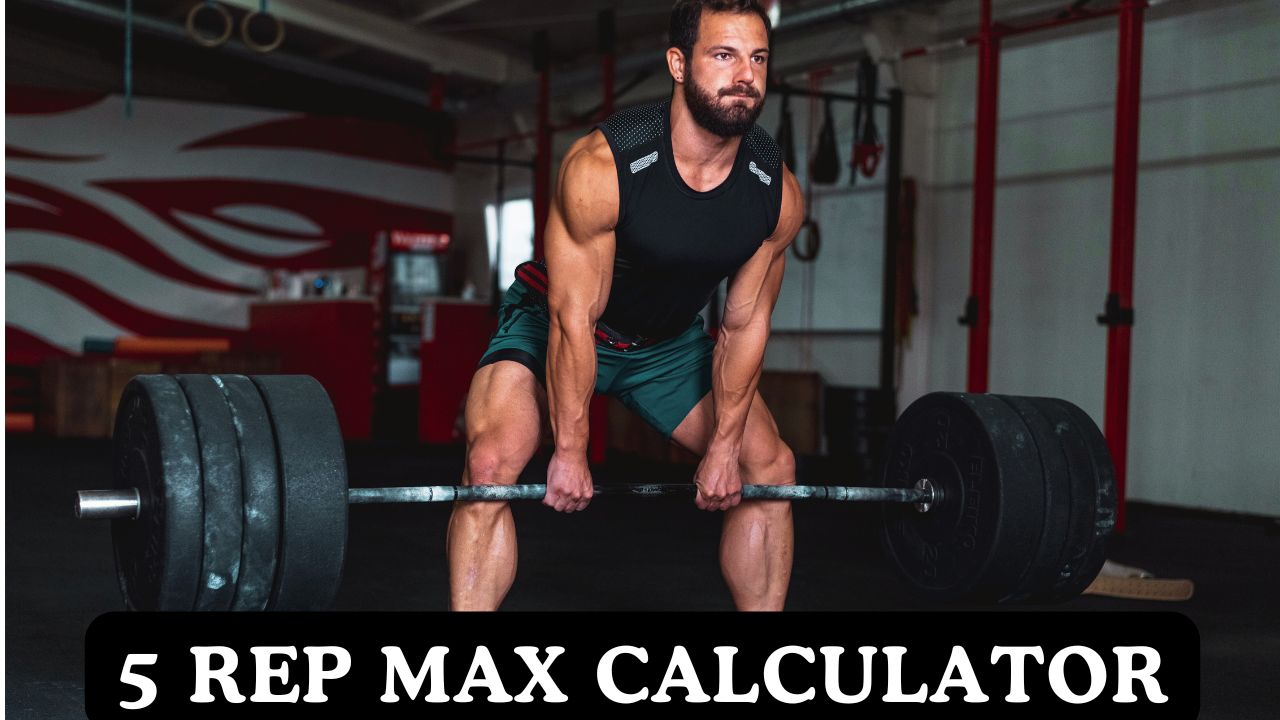🏋️ 5 Rep Max Calculator
Calculate your Five Rep Max (5RM) using scientifically validated formulas. Get personalized training recommendations and percentage-based workout plans optimized for strength endurance, hypertrophy, and power development.

Five Rep Max (5RM) Training
Scientific Foundation
The Five Rep Max (5RM) represents the maximum weight an individual can lift for exactly five repetitions with proper form. Research in Sports Medicine demonstrates that 5RM testing provides an optimal balance between strength assessment and hypertrophy stimulus. The 5RM typically represents approximately 87% of an individual’s 1RM, making it ideal for strength-endurance training and muscle development programs.
Training Applications
Systematic reviews in strength training show that 5RM-based programming is particularly effective for intermediate lifters seeking balanced strength and hypertrophy gains. Training at 80-90% of 5RM optimizes strength development, while 70-80% promotes significant muscle growth. The 5RM serves as an excellent benchmark for periodized training focused on strength-endurance and muscle building.
Hypertrophy Benefits
Muscle hypertrophy research indicates that the 5RM rep range provides optimal mechanical tension and metabolic stress for muscle growth while maintaining significant strength gains. This rep range allows for sufficient training volume to stimulate hypertrophy while building substantial strength capacity.
Practical Applications
Contemporary strength research demonstrates that 5RM testing is highly practical for regular strength assessment and program design. It provides reliable data for training load prescription, can be performed more frequently than lower rep maxes, and is particularly valuable for bodybuilders and strength athletes focused on balanced development.
5RM Calculation Methods & Formulas
Brzycki Formula for 5RM
Formula: 5RM = (1RM × 36 ÷ (37 – Reps)) × 0.87
Validation research
shows the Brzycki formula provides highly accurate 5RM predictions when combined with the standard 87% conversion factor.
This method is particularly effective for compound movements and repetition ranges of 3-12.
Epley Formula for 5RM
Formula: 5RM = (Weight × (1 + 0.0333 × Reps)) × 0.87
The Epley formula, when adjusted for 5RM calculation, provides excellent accuracy across multiple exercise types and training levels.
This formula is particularly versatile for both upper and lower body exercises, making it suitable for comprehensive
strength assessment and program design.
Direct 5RM Testing
Protocol: Progressive loading to determine actual 5RM
Direct 5RM testing involves systematic load increases until the lifter can complete exactly five repetitions with
maximum effort. This method provides highly accurate assessment and is safer than lower rep testing while still providing
valuable strength data. Recommended for all training levels with proper warm-up protocols.
Average Method Precision
Approach: Combined formula average for enhanced accuracy
Using multiple formulas and averaging the results provides superior accuracy compared to single-formula calculations.
This method reduces individual formula bias and provides more reliable 5RM estimates across different population groups,
training levels, and exercise variations.
5RM vs Other Rep Maxes: Comparative Analysis
| Aspect | 5RM Testing | 1RM Testing | 10RM Testing | Best For |
|---|---|---|---|---|
| Safety | Moderate risk | Higher risk | Lower risk | 5RM/10RM |
| Strength Assessment | Excellent | Maximum | Good | 1RM/5RM |
| Hypertrophy Stimulus | High | Low | Very High | 5RM/10RM |
| Testing Frequency | Weekly | Monthly | Bi-weekly | 5RM |
| Form Maintenance | Good | Challenging | Excellent | 10RM |
| Training Specificity | High | Competition specific | Moderate | Depends on goal |
When to Use 5RM Testing
Ideal Situations:
• Balanced strength and hypertrophy programs
• Intermediate to advanced lifters
• Regular strength assessment during training cycles
• Bodybuilding and physique-focused training
• Athletes requiring strength-endurance
• When seeking optimal training volume for muscle growth
Standard 5RM Strength Benchmarks
Male 5RM Strength Standards (kg)
| Exercise | Beginner | Novice | Intermediate | Advanced | Elite |
|---|---|---|---|---|---|
| Bench Press | 30-45kg | 45-65kg | 65-85kg | 85-110kg | 110kg+ |
| Squat | 40-60kg | 60-80kg | 80-110kg | 110-140kg | 140kg+ |
| Deadlift | 50-75kg | 75-105kg | 105-135kg | 135-170kg | 170kg+ |
| Overhead Press | 18-30kg | 30-45kg | 45-60kg | 60-75kg | 75kg+ |
Female 5RM Strength Standards (kg)
| Exercise | Beginner | Novice | Intermediate | Advanced | Elite |
|---|---|---|---|---|---|
| Bench Press | 15-25kg | 25-40kg | 40-55kg | 55-70kg | 70kg+ |
| Squat | 20-35kg | 35-55kg | 55-75kg | 75-95kg | 95kg+ |
| Deadlift | 30-50kg | 50-70kg | 70-90kg | 90-115kg | 115kg+ |
| Overhead Press | 10-18kg | 18-28kg | 28-38kg | 38-50kg | 50kg+ |
5RM Standards Interpretation
These 5RM standards are based on extensive strength data from recreational to competitive lifters, adjusted to represent approximately 87% of 1RM values. Standards assume proper technique, adequate training experience, and good health status. Individual variations exist based on body weight, training history, genetics, and age. The 5RM is particularly valuable for tracking progress in strength-endurance and hypertrophy-focused programs.
5RM-Based Periodization Model
| Training Phase | Duration | Intensity (%5RM) | Volume (Reps) | Sets | Rest Period | Primary Adaptation |
|---|---|---|---|---|---|---|
| Hypertrophy Foundation | 4-6 weeks | 65-75% | 10-15 | 3-4 | 1-2 min | Muscle growth, volume |
| Strength-Hypertrophy | 4-6 weeks | 75-85% | 6-10 | 4-5 | 2-3 min | Balanced development |
| Strength Emphasis | 3-4 weeks | 85-95% | 5-8 | 4-6 | 3-4 min | Strength, neural adaptation |
| Peak Strength | 2-3 weeks | 90-100% | 3-6 | 3-5 | 3-5 min | Maximum strength |
| Recovery | 1 week | 50-65% | 8-12 | 2-3 | 1-2 min | Active recovery |
5RM Periodization Benefits
Periodization research demonstrates that 5RM-based programming provides excellent balance between strength and hypertrophy development. The ability to regularly test and adjust 5RM values allows for precise load prescription and optimal training stimulus for both strength and muscle growth objectives.
Advanced 5RM Training Techniques
5RM Rest-Pause Training
Protocol: 5RM weight for 5 reps, rest 15 seconds, continue for 2-3 more reps
Benefits: Increased training volume, enhanced hypertrophy stimulus
This method allows for greater training volume at 5RM intensity, maximizing both strength and muscle growth adaptations.
5RM Pyramid Training
Protocol: 70% × 8, 80% × 6, 90% × 5, 100% × 5, 90% × 5, 80% × 6
Benefits: Progressive overload, volume accumulation
Particularly effective for intermediate lifters seeking balanced strength and hypertrophy development.
5RM Tempo Training
Method: Controlled eccentric (3-4 seconds) with 5RM loads
Benefits: Enhanced muscle damage, improved strength in lengthened position
Excellent for bodybuilders and physique athletes seeking maximum hypertrophy stimulus.
Frequently Asked Questions
How often should I test my 5RM?
Beginners: Every 4-6 weeks during strength phases
Intermediate: Every 3-4 weeks or at phase transitions
Advanced: Every 2-3 weeks during strength-hypertrophy blocks
Bodybuilders: Every 4-6 weeks for program adjustment
5RM testing can be performed more frequently than 1RM testing while providing valuable training data.
What’s the proper 5RM testing protocol?
Warm-up Protocol:
1. General warm-up: 5-10 minutes light cardio
2. Dynamic stretching and activation
3. 50% 5RM × 8-10 reps
4. 70% 5RM × 6-8 reps
5. 85% 5RM × 5 reps
6. 95% 5RM × 5 reps
7. 5RM attempt
Rest 2-3 minutes between warm-up sets, 3-4 minutes before 5RM attempt.
How does 5RM relate to other training intensities?
Standard Relationships:
• 1RM = 5RM ÷ 0.87 (approximately 115% of 5RM)
• 3RM = 5RM × 1.03 (approximately 103% of 5RM)
• 8RM = 5RM × 0.92 (approximately 92% of 5RM)
• 10RM = 5RM × 0.87 (approximately 87% of 5RM)
These relationships help in programming various training intensities based on 5RM values.
Is 5RM testing suitable for all training levels?
5RM testing is suitable for most training levels, from advanced beginners to elite athletes. It provides an excellent balance between strength assessment and training stimulus. Beginners should have at least 4-6 weeks of consistent training experience and demonstrate proper technique before attempting 5RM tests. The rep range is particularly valuable for those focused on balanced strength and muscle development.
What are the signs of a successful 5RM attempt?
Technical Indicators:
• All five repetitions completed with proper form
• Consistent tempo and range of motion
• No significant form breakdown on final reps
• Controlled movement throughout entire set
• Unable to complete a sixth repetition
• Moderate to high RPE (8-9 out of 10)
If form remains excellent and additional reps are clearly possible, the weight may not represent a true 5RM.
Related
- Barbell Racking Calculator
- Push-Up Weight Calculator
- Wilks Calculator
- One-Rep (1RM) Max Calculator
- One-Rep Max (1RM) Bench Press Calculator
References
- Mayhew, Jerry L; Johnson, Blair D; LaMonte, Michael J; Lauber, Dirk; Kemmler, Wolfgang (September 2008). “Accuracy of Prediction Equations for Determining One Repetition Maximum Bench Press in Women Before and After Resistance Training”. Journal of Strength and Conditioning Research. 22 (5): 1570–1577.
- Knutzen, Kathleen; Brilla, Lorraine; Caine, Dennis (August 1999). “Validity of 1RM Prediction Equations for Older Adults”. The Journal of Strength & Conditioning Research. 13 (3): Vol 13, Issue 3, Page 242–246. Retrieved 11 July 2014.
- Epley, Boyd (1985). “Poundage Chart”. Boyd Epley Workout. Lincoln, NE: Body Enterprises. p. 86.
- Brzycki, Matt (1998). A Practical Approach To Strength Training. McGraw-Hill.
- Kemmler, Wolfgang K.; Lauber, Dirk; Wassermann, Alfred; Mayhew, Jerry L. (2006-11-01). “Predicting maximal strength in trained postmenopausal woman”. Journal of Strength and Conditioning Research. 20 (4): 838–842.
- Chapman, Paul P.; Whitehead, James R.; Binkert, Ronald H. (November 1998). “The 225–1b Reps-to-Fatigue Test as a Submaximal Estimate of 1-RM Bench Press Performance in College Football Players”. Journal of Strength and Conditioning Research. 12 (4): 258–261.
- Reynolds, JM; Gordon, TJ; Robergs, RA (August 2006). “Prediction of one repetition maximum strength from multiple repetition maximum testing and anthropometry” (PDF). Journal of Strength and Conditioning Research. 20 (3): 584–92.
- Naclerio Ayllón, Fernando; Jiménez Gutiérrez, Alfonso; Alvar, Brent A.; Peterson, Mark D. (2009). “Assessing strength and power in resistance training”. Journal of Human Sport and Exercise. 4 (2): 100–113.

Manish is a NASM-certified fitness and nutrition coach with over 10 years of experience in weight lifting and fat loss fitness coaching. He specializes in gym-based training and has a lot of knowledge about exercise, lifting technique, biomechanics, and more.
Through “Fit Life Regime,” he generously shares the insights he’s gained over a decade in the field. His goal is to equip others with the knowledge to start their own fitness journey.
